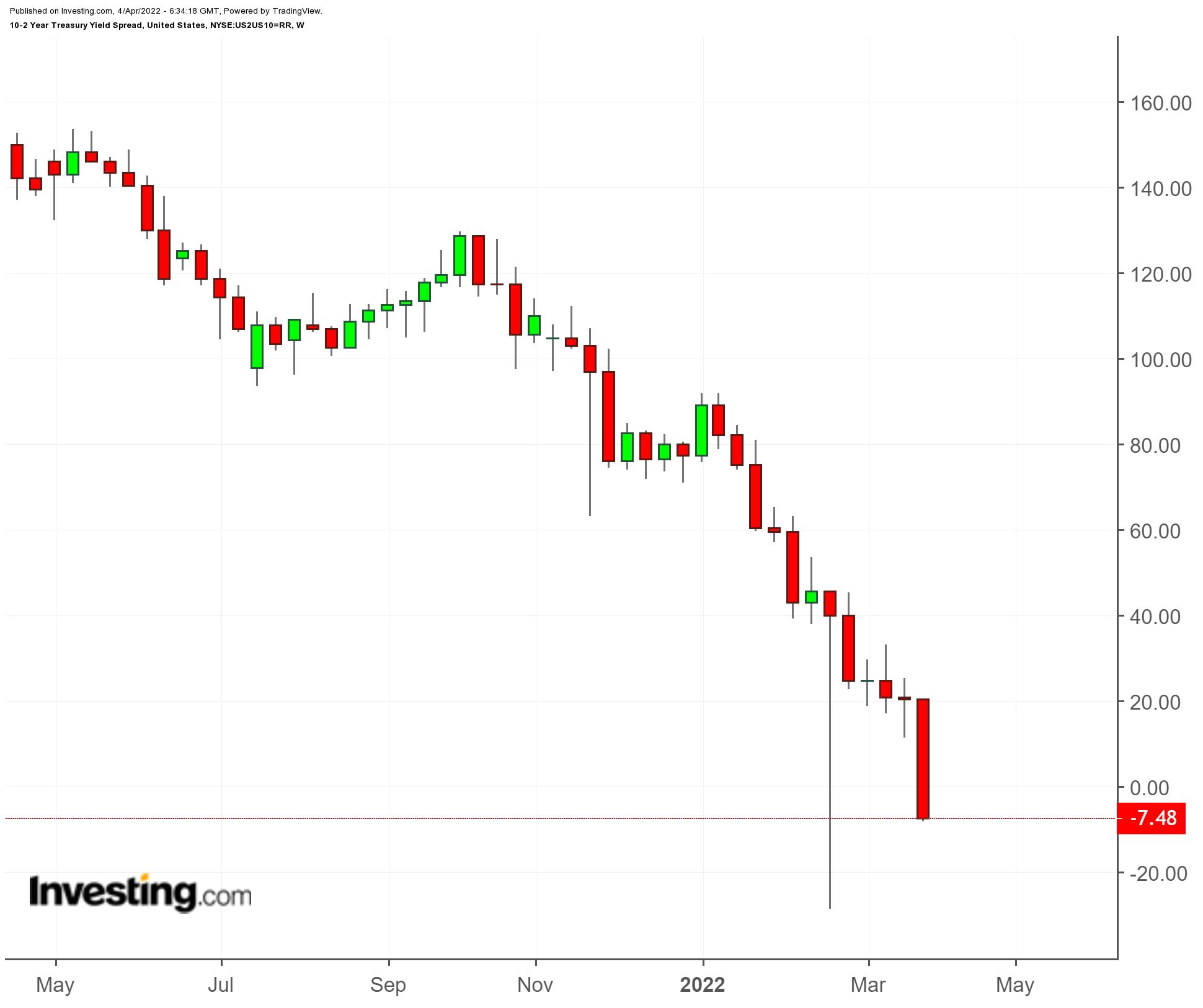The dreaded inversion of the yield curve has taken place as an emerging consensus that the Federal Reserve will be more aggressive in raising rates led to a selloff of US Treasuries—hitting the two-year note hardest, so that its yield topped that of the 10-year note.

A yield curve inversion like this has historically heralded a recession, though the timing has been imprecise. The thinking is that monetary tightening, reflected in higher short-term rates, will dampen demand and provoke a recession, which will result longer term in an easing of monetary policy and lower rates.
San Francisco Fed President Mary Daly, who has been a champion of a more gradual increase in rates, is part of the momentum for tougher Fed action. She said Friday in an interview with the Financial Times that the chances for a 50 basis point increase at the next policy meeting in May are higher now.
"The case for 50, barring any negative surprise between now and the next meeting, has grown. I’m more confident that taking these early adjustments would be appropriate."
Strong hiring in March, pushing the unemployment rate down to 3.6% from 3.8%, suggests that a robust labor market can withstand tighter monetary policy even as it indicates continued pressure on wages and prices.
The inflation gauge used by the Fed—the personal consumption expenditures index—showed a year-on-year increase of 6.4% for February, when it was released last Thursday. Even the so-called core inflation rate closely watched by Fed policymakers because it eliminates volatile food and energy prices was up 5.4% on the year. Both marked increases from the previous reading.
St. Louis Fed chief James Bullard, who dissented from the March vote of the Federal Open Market Committee to raise the policy rate a quarter-point because he wanted a stronger increase, repeated his call for monetary tightening. He wrote on the regional bank’s website last week:
"The labor market has fully recovered from the recession by nearly every measure, and it has gone beyond pre-recession levels by several measures. Moreover, inflation is running well above the 2% rate that the FOMC equates with price stability, and monetary policy has not been reset for these macroeconomic conditions. That is why it is necessary for the FOMC to remove monetary policy accommodation."
The Fed has said it will tolerate a certain period of running above its inflation target to average things out, but Bullard calculates that the average PCE core inflation for the period 2019 through 2023, using policymakers’ own forecasts, would be 2.9%, significantly higher than the target. If the Fed doesn’t act quickly to increase interest rates and run off the $9 trillion bond portfolio, he goes on to warn, "we risk squandering policy credibility with respect to the 2% inflation target."
Fed policymakers are still preaching that their goal is to achieve a soft landing for the economy. New York Fed chief John Williams, always the optimist, still sees this as an achievable result as the Fed tightens monetary policy in tandem with other countries:
"These actions should enable us to manage the proverbial soft landing in a way that maintains a sustained strong economy and labor market. Both are well positioned to withstand tighter monetary policy. In fact, I expect the economy to continue to grow this year and for the unemployment rate to remain close to its current level."
Some analysts are not so sanguine. Lisa Shalett, chief investment officer at Morgan Stanley Wealth Management, listed three reasons why hopes for a soft landing may be mistaken: overvalued stocks, underestimating the impact of the Fed’s bond portfolio runoff, and a misplaced belief the Fed will intervene to shield stock market investors.
In any case, the Fed doesn’t have a great track record in pulling off soft landings, and this time faces the additional challenge of external shocks from the Ukraine invasions and subsequent supply disruptions.
Alan Blinder, a former vice chairman of the Fed, has found that the Fed engineered only one soft landing over the past 11 cycles of monetary tightening. Even if two other instances didn’t qualify as an official recession, that leaves eight instances of hard landings. Not great odds.
